Suchergebnisse
Vitality City - Ganzheitliche Energiestrategien für Städte im Wandel
Energiesimulation von Städten & Gemeinden beliebiger Größe auf Grundlage von Daten aus Laserscanning und Satellitenanalyse (Geodaten), um den dynamischen Energiebedarf und die verfügbaren Energieressourcen zu ermitteln.
IMPACT – Hybrid hydraulic and electric charging of stratified compact hot water
Das Projekt IMPACT entwickelt eine innovative dezentrale Warmwasserspeicher-Technologie für den großvolumigen urbanen Wohnbau. Durch ein neuartiges, flaches Design ermöglicht das System eine hocheffiziente Nutzung erneuerbarer Energiequellen wie Wärmepumpen und Photovoltaik. Ziel ist eine kosteneffiziente, nachhaltige Lösung zur Dekarbonisierung der Warmwasseraufbereitung, die mittels intelligenter Energiemanagement- und Machine-Learning-Methoden optimiert wird.
ExTra - ExergieTrafos zum Heizen und Klimatisieren durch Fernwärme
Das Projekt "Extra – ExergieTrafos zum Heizen und Kühlen durch Fernwärme" untersucht innovative Technologien zur Steigerung der Effizienz und Reduktion der Umweltbelastungen von Fernwärme- und Fernkältesystemen in Österreich. Durch die Integration von Absorber- und Ejektorschaltungen wird eine kombinierte Bereitstellung von Wärme und Kälte ermöglicht. Die Ergebnisse zeigen, dass Absorbersysteme die höchste exergetische Effizienz und die geringsten CO2-Emissionen aufweisen, was sie zu einer nachhaltigen Lösung für urbane Anwendungen macht.
Vilipa - Erkennung von Personen und Gruppen in bestehenden Gebäuden auf Basis von sichtbarem Licht
Evaluierung der technischen und wirtschaftlichen Machbarkeit eines Belegungserkennungssystems basierend auf der Technologie des Visible-Light-Sensings, das in Kombination mit der Gebäudeleittechnik den Energieverbrauch von Gebäuden senken soll. Ziel ist es low-tech/low–complexity Lösungen zu realisieren, die allein durch die Erfassung der Reflexionen des sichtbaren Lichts zwischen einzelnen Personen und Gruppen unterscheiden können.
Beyond - Virtual Reality-fähige Energiedienste für intelligente Energiesysteme
Das Projekt "Beyond" behandelte zwei unterschiedliche Energiedienstleistungen durch das Zusammenspiel verschiedener Technologien: hochmoderne virtuelle Realität (VR), das Internet der Dinge (IoT), Energiesimulation und maschinelles Lernen (ML). Der Energiedienstleistung 1 versetzt VR-Nutzer durch ein lehrreiches VR-Spiel in energieeffizientes und nachhaltiges Gebäudedesign, während der Energiedienstleistung 2 die Instandhaltung von Gebäudesystemen, insbesondere eines Heizung, Lüftung und Klimaanlage (HLK)-Systems, durch die Anwendung von ML-Modellen für vorausschauende Wartung verbessert.
Beyond - Virtual Reality enabled energy services for smart energy systems
The Beyond project addressed two different energy services through the interaction of various technologies: state-of-the-art virtual reality (VR), the Internet of Things (IoT), energy simulation and machine learning (ML). Energy service 1 immerses VR users in energy-efficient and sustainable building design through an educational VR game, while energy service 2 improves the maintenance of building systems, particularly heating, ventilation and air conditioning (HVAC) systems, through the application of ML models for predictive maintenance.
Vilipa - Visible light based Person and Group Detection in existing buildings
Zur Reduktion des Energieverbrauchs von Gebäuden können Belegungserkennungssysteme einen großen Beitrag leisten. Dieses Projekt zeigt die Machbarkeit des Erkennens von Personen anhand der Reflexion von sichtbarem Licht, hervorgerufen durch die Person selbst, demonstriert, wobei die bestehende Beleuchtungsinfrastruktur zur Personenerkennung ohne Datenschutzbedenken eingesetzt werden kann. Der realisierte Ansatz ist sowohl kostengünstig als auch unaufwändig hinsichtlich der Installationskosten.
ExTra - ExergyTrafos for heating and air conditioning through district heating
As a contribution to the reduction of CO2 emissions, the project aims at upgrading existing heating networks by adding new devices, so-called exergy trafos, to the heat-exchanging transfer stations. These are driven by district heat and provide heating and cooling, as well as a reduced return temperature, as a service.
sustAIn4Build – KI-Kompetenz für nachhaltiges Gebäudemanagement in klimaneutralen Städten
Das Projekt sustAIn4Build zielt darauf ab, die Energieeffizienz und Nachhaltigkeit im Gebäudetechniksektor durch den gezielten Einsatz von Künstlicher Intelligenz (KI) zu steigern. Durch branchenspezifische Weiterbildungsmaßnahmen werden österreichische Unternehmen befähigt, KI-Technologien effektiv in ihre Prozesse zu integrieren, um ressourcenschonende, kosteneffiziente und nachhaltige Lösungen zu entwickeln. Dies stärkt deren Wettbewerbsfähigkeit und trägt zur Erreichung der europäischen Dekarbonisierungsziele bei.
sustAIn4Build - AI competence for sustainable building management in climate neutral cities
The objective of the project sustAIn4Build is to increase energy efficiency and sustainability in the building sector by using artificial intelligence (AI). Industry-specific training programs support Austrian companies to develop a workflow for integrating AI technologies into their processes, enabling them to develop resource-saving, cost-effective and sustainable solutions. This strengthens their competitiveness and contributes to the achievement of European decarbonisation goals.
BIOCOOL - Bio-inspirierte Oberflächen zur Verdunstungskühlung von Gebäudehüllen
Das Projekt Biocool ist eine Sondierung zur Übertragung von morphologischen Prinzipien von Blättern von Laubbäumen, die für thermische Eigenschaften und Verdunstungseffizienz optimiert sind, in parametrisches Design architektonischer, formoptimierter Oberflächen aus Keramik zur Klimatisierung von Gebäudehüllen. Diese Studie bereitet den Weg für ein industrielles Forschungsprojekt.
BIOCOOL - Bio-inspired Surfaces for the Evaporation Cooling of Building Envelopes
The BIOCOOL project will explore the transfer of morphological principles from leaves of deciduous trees, with optimized thermal properties and efficiency of evaporation to the parametric design of form-optimized architectural ceramic surfaces for climate control of building envelopes. The study paves the way for an industrial research project.
Bio-inspirierte Oberflächen zur Verdunstungskühlung von Gebäudehüllen (BIOCOOL)
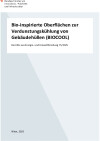
Das Projekt Biocool ist eine Sondierung zur Übertragung von morphologischen Prinzipien von Blättern von Laubbäumen, die für thermische Eigenschaften und Verdunstungseffizienz optimiert sind, in parametrisches Design architektonischer, formoptimierter Oberflächen aus Keramik zur Klimatisierung von Gebäudehüllen. Diese Studie bereitet den Weg für ein industrielles Forschungsprojekt.
Schriftenreihe
75/2025
B. Sommer, Damjan Minovski, Małgorzata Sommer-Nawara, Sascha Zaitseva, Ulrich Pont, Matthias Schuss, M. Balzar, P. Gruber, D. Koschitz, G. Moncayo Asan, C. Yönetim-Rabl, H. Teufl, M. Martens-Wiala, G. Pfaffl, H. Rachbauer
Herausgeber: BMIMI
Deutsch, 81 Seiten
Downloads zur Publikation
CoolAIR - Prädiktiv geregelte passive Gebäudekühlung mittels natürlicher Nachtlüftung und tageslichtoptimierter Verschattung
Natürliche Nachtlüftung und tageslichtoptimierte Verschattung haben v.a. in ihrer Kombination ein hohes Potential Gebäude energieeffizient zu kühlen, werden aktuell jedoch meist nur manuell gesteuert und damit nicht optimal genutzt. Ziel ist die Entwicklung einer automatisierten und selbstlernenden Lösung, die dieses Kühlpotential voll ausgeschöpft und so eine Alternative zu Klimageräten bietet.
CoolAIR - Predictive control of natural nighttime ventilation and daylight-optimized shading for passive building cooling
Natural nighttime ventilation and daylight-optimized shadowing are high potential approaches to efficiently and economical cool buildings. Nevertheless, the full potential cannot be acquired, since, if at all, such behavior is manually initiated by users. Goal of this project is the development of an automated, self-learning system that can assess the full cooling capabilities and establish an alternative to conventional air conditioning systems.
Prädiktiv gesteuerte passive Gebäudekühlung mittels natürlicher Nachtlüftung und tageslichtoptimierter Verschattung (CoolAIR)
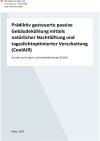
Natürliche Nachtlüftung und tageslichtoptimierte Verschattung haben v.a. in ihrer Kombination ein hohes Potential Gebäude energieeffizient zu kühlen, werden aktuell jedoch meist nur manuell gesteuert und damit nicht optimal genutzt. Ziel ist die Entwicklung einer automatisierten und selbstlernenden Lösung, die dieses Kühlpotential voll ausgeschöpft und so eine Alternative zu Klimageräten bietet.
Schriftenreihe
78/2025
Daniela Trauninger, Albert Treytl, Markus Winkler, Klaus Winiwarter, Aleksey Bratukhin, Thomas Posnicek, Wolfgang Stumpf, Christian Heschl, Florian Wenig, Bernhard Derler, Stefan Langerwisch, Lukas Unterpertinger, Johannes Schnitzer, Johann Gerstmann, Paul Erdely, Gerald Peischl, Thomas Szuborics, Michael Woschitz, Rainer Zach, Christian Heiligenbrunner, Benjamin Guzei, Manfred Fürstner
Herausgeber: BMIMI
Deutsch, 114 Seiten
Downloads zur Publikation
HPZ-Mauerwerk - Dämmstofffreie High-Performance-Außenwand aus Ziegelmauerwerk
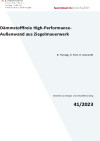
Um nachhaltige Quartiere in Ziegelbauweise realisieren zu können, muss die Festigkeit des thermisch optimierten Hochlochziegels verdreifacht werden. Dies soll durch Veränderung des Lochbilds, nämlich durch Verkleinerung des Luftspalts von 8 auf 4 mm gelingen. Ein erfolgreicher Projektabschluss bildet die Basis für dämmstofffreie, 8-geschossige Wohn- und Bürogebäude in Ziegelbauweise.
Schriftenreihe
41/2023
B. Freytag, H. Ferk, H. Gamerith
Herausgeber: BMK
Deutsch, 38 Seiten
Downloads zur Publikation
Entwicklung einer „Merit-Order“ bei Regenerationswärme für Erdsondenfelder in urbanen Wohngebieten (ecoRegeneration)
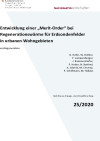
In urbanen Wohngebieten gibt es zu wenig aktiv-gekühlte Nutzungen, um die Abwärme des Kühlprozesses als erforderliche Regenerationswärme für Erdsondenfelder verwenden zu können; Das Free-Cooling der Wohnungen bietet eine zu geringe Wärmemenge. Das Projekt prüft verschiedene Optionen (Abwärme von Gewerbenutzungen in Erdgeschoßzonen, gezielte Ansiedelung von Datenzentren, zusätzliche Installation von Wärmebereitstellungssystemen) innerhalb des Siedlungsgebietes, erarbeitet Geschäftsmodelle und bewertet den Wärmepreis sämtlicher Lösungen, sodass eine Art „Merit-Order“ für Regenerationswärme erstellt werden kann.
Schriftenreihe
25/2020
G. Hofer, W. Hüttler, P. Lampersberger, J. Rammerstorfer, P. Holzer, N. Bartlmä, A. Schmid, M. Cerveny, P. Schöfmann, M. Hollaus
Herausgeber: BMK
Deutsch, 48 Seiten
Downloads zur Publikation
Missing Link für die Planung CO2-neutraler Gebäude (6D-BIM-Terminal)
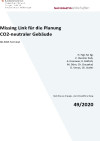
Das Projekt soll die Lücke zwischen FachkonsulentInnen und Building Information Modeling (BIM) Applikationen schließen. Daten, die für die Betrachtung von Kosten, Terminen und Nachhaltigkeitsaspekten notwendig sind, sollen bei BIM-Elementen ergänzt und in die jeweilige Fachplanungs-Software eingelesen werden können. Der Datenaustausch soll unter Verwendung der IFC-Schnittstelle nach ÖN A6241-2 und der Merkmale des ASI-Merkmalservers über eine zentrale Plattform, das „6D BIM-Terminal“, erfolgen.
Schriftenreihe
49/2020
H. Figl, M. Ilg, V. Huemer Kals, A. Krenauer, K. Battisti, M. Dörn, Ch. Doczekal, D. Venus, Ch. Sutter
Herausgeber: BMK
Deutsch, 46 Seiten
Downloads zur Publikation
Joining Cards - Untersuchung rückbaubarer Verbindungs- und Fügetechniken zur Entwicklung monomaterieller Innenausbausysteme aus Karton
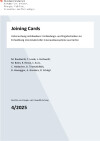
Strategische Auseinandersetzung mit Kartonprodukten und Papierwerkstoffen zur Entwicklung rückbaubarer Innenausbausysteme und der Definition von Baukomponenten und ihrer Schnittstellen. Das Ergebnis bildet in Form eines umfassenden Erkenntnisgewinns die Grundlage für weiterführende Forschungsprojekte.
Schriftenreihe
4/2025
M. Raudaschl, T. Levak, L. Gschweitl, M. Boles, R. Riewe, C. Kurz, C. Haidacher, G. Triantafyllidis, B. Hausegger, A. Gündera, D. Schlegl
Herausgeber: BMK
Deutsch, 66 Seiten
